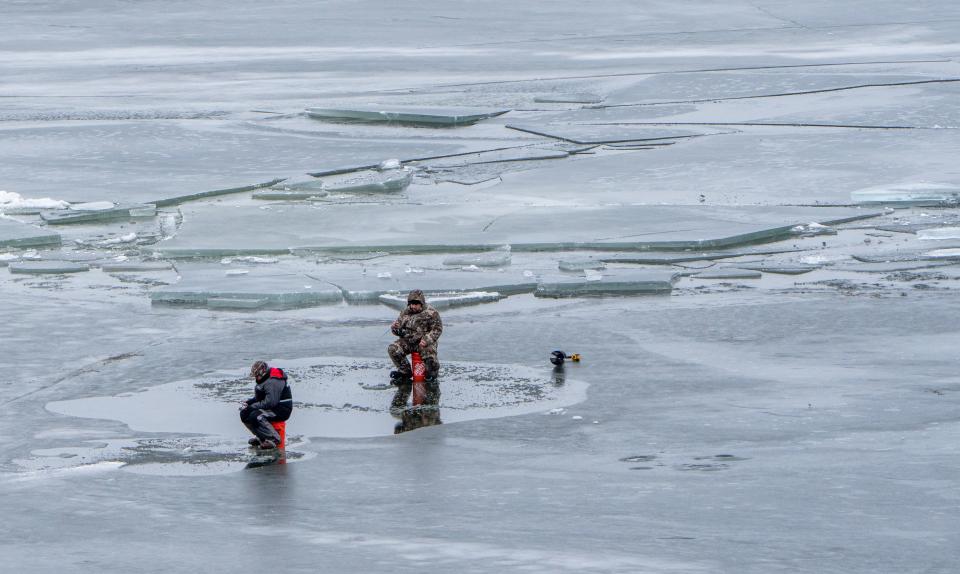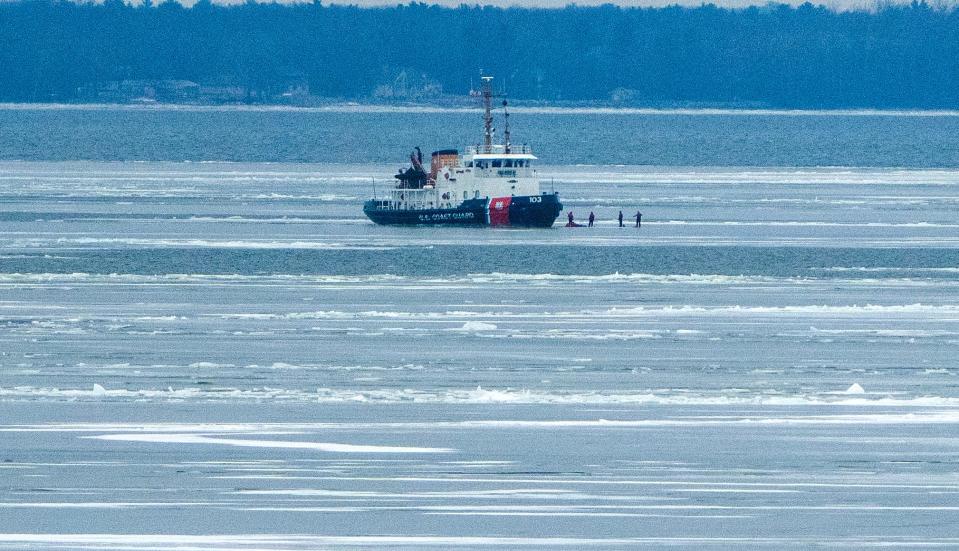It's mid-January and the Great Lakes are virtually ice-free. That's a problem.
It’s the middle of January, and the Great Lakes are basically ice-free.
Ice has been slow to form this year, with only 3.2% of the lakes covered as of Jan. 19. That's a near-record low, and roughly 18% below average for this time of year.
And while it’s still unclear how things will shake out for the rest of the season, no ice isn’t a good thing for the lakes’ ecosystem. It can even stir up dangerous waves and lake-effect snowstorms.
So, what happens when the lakes are ice-free? What does it mean for the lakes’ food web? Is climate change to blame?
Here are five things you should know.

Ice cover is at a near-record low, but things can change
The U.S. National Ice Center Forecast releases a seasonal outlook at the beginning of December, which showed a mix of predictions. According to the forecast, Lakes Michigan, Erie and Ontario are predicted to have less ice, while Lake Superior is expected to be above normal. Lake Huron is expected to have an average year.
But this three-month prediction has a great deal of uncertainty, and much can change, said Ayumi Fujisaki Manome, a scientist at the Cooperative Institute for Great Lakes Research at the University of Michigan who models ice cover and hazardous weather across the lakes.
Ice growth is pretty dynamic; it's course can realign in a matter of days, especially on the shallower lakes.
Ice cover jumped up to 7% on average across all the lakes after the December cold snap, for example, but then quickly fell as milder temperatures rolled in. The change was especially pronounced on Lake Erie, where ice cover rose to 23% and now sits at around 3%. Lake Erie typically freezes over the quickest and has the most ice cover because it's the shallowest of the Great Lakes.
Lake Michigan saw more than 7.5% ice coverage after the December cold spell, and measured at nearly 3.2 percent last Friday. Nearly all of that ice is in the bay of Green Bay.
More:Are we in a new era for the Great Lakes?
Less ice means more snow
Less ice cover doesn’t mean that residents around the Great Lakes are getting an easier winter. In fact it can be the opposite.
In the winter, when cold, dry air masses move across the lakes, they pick up water along the way through evaporation. When the air mass hits land, it drops all that water through lake-effect snow.
Ice cover acts as a shield, stopping water from evaporating off the lake, Fujisaki Manome said. So, when there is less ice people around the lakes typically see more lake-effect snow.
More: What causes lake-effect snowstorms? And what’s the probability for Wisconsin?
Most lake evaporation actually happens in the fall and winter months opposed to the summer, Fujisaki Manome said.
Little ice cover can be disastrous
This winter has already proven how dangerous lake-effect snow can be.
At the end of November, more than six feet of snow fell on Buffalo, N.Y., which sits on the shores of Lake Erie. A few weeks later on Dec. 23, more than four feet of snow covered the city and surrounding areas once again. The storm resulted in 44 deaths in Erie and Niagara counties, which sit on Lakes Erie and Ontario, respectively.
During stormy winter months, ice cover tempers waves. When there is low ice cover, waves can be much larger, leading to lakeshore flooding and erosion. That happened in January 2020 along Lake Michigan’s southwestern shoreline. Record high lake levels mixed with winds whipped up 15-foot waves that flooded shorelines, leading Gov. Tony Evers to declare a state of emergency for Milwaukee, Racine and Kenosha counties.
And while less ice may seem like a good thing for the lakes’ shipping industry, those waves can create dangerous conditions.
The Great Lakes are losing ice with climate change
The Great Lakes have been losing ice for the past five decades, a trend that scientists say will likely continue.

Of the last 25 years, 64% had below-average ice, said Michael Notaro, the director of the Center on Climatic Research at the University of Wisconsin-Madison. The steepest declines have been in the north, including Lake Superior, northern Lake Michigan and Huron, and in nearshore areas.
More: What's the state of the Great Lakes? Successful cleanups tempered by new threats from climate change
But this also comes with a lot of ups and downs, largely because warming is causing the jet stream to “meander,” Fujisaki Manome said.
There is a lot of year-to-year variability with ice cover spiking in years like 2014, 2015 and 2019 where the lakes were almost completely iced over.
No ice makes waves in the lakes’ ecosystems
A downturn in ice coverage due to climate change will likely have cascading effects on the lakes’ ecosystems.
Lake whitefish, a mainstay in the lakes’ fishing industry and an important food source for other fish like walleye, are one of the many Great Lakes fish that will be impacted, said Ed Rutherford, a fishery biologist who also works at the Great Lakes Environmental Research Laboratory.
Lake whitefish spawn in the fall in nearshore areas, leaving the eggs to incubate over the winter months. When ice isn’t there, strong winds and waves can stir up the sediment, reducing the number of fish that are hatched in the spring, Rutherford said.
Walleye and yellow perch also need extended winters, he said. If they don’t get enough time to overwinter in cold water, their eggs will be a lot smaller, making it harder for them to survive.
Declining ice cover on the lakes is also delaying the southward migration of dabbling ducks, a group of ducks that include Mallards, out of the Great Lakes in the fall and winter, Notaro said. And if the ducks spend more time in the region it will increase the foraging pressure on inland wetlands.
Warming lakes and a loss of ice cover over time also will be coupled with more extreme rainfall, likely inciting more harmful algae blooms, said Notaro. These blooms largely form from agricultural runoff, creating thick, green mats on the lake surface that can be toxic to humans and pets.
Lakes Erie and Michigan are plagued with these blooms every summer. And now, blooms are cropping up in Lake Superior for the first time are raising alarm.
“Even deep, cold Lake Superior has been experiencing significant algae blooms since 2018, which is quite atypical,” Notaro said.
There is still a big question mark on the extent of the changes that will happen to the lakes’ ecosystem and food web as ice cover continues to decline. That’s because scientists can’t get out and sample the lakes in the harsh winter months.
“Unless we can keep climate change in check… it will have changes that we anticipate and others that we don’t know about yet,” Rutherford said.
Caitlin Looby is a Report for America corps member who writes about the environment and the Great Lakes. Reach her at clooby@gannett.com or follow her on Twitter @caitlooby.
This article originally appeared on USA TODAY: Great Lakes' lack of ice upends food web, incites algae blooms

